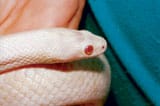Tightly inbreeding lines of distinctive morphs is fairly common in herpetoculture.
Q. Last season I hatched an extremely colorful crested gecko (Rhacodactylus ciliatus). It likely received its bright colors from its male parent. If it turns out to be female, I would like to breed it back to the father.
Is inbreeding a concern at this first generation? Would I be better off, either in the genetic health of the animal or in achieving higher-colored animals, if I bred it to a different bloodline?
Neal Grant
Topeka, Kansas
A. Tightly inbreeding lines of distinctive morphs is fairly common in herpetoculture. It seldom has negative consequences, and it is usually the fastest way to produce offspring that display or at least carry the genes for an interesting trait. However, it is never recommended that a morph be inbred for more than the minimum number of generations necessary to get enough specimens to start outbreeding the line.
The fear of harmful results from inbreeding animals is generally exaggerated, coming more from a few misunderstood problems in human genetics. Many reptile populations are tightly inbred already. These descend from just a few ancestors that either suddenly found themselves in a new location (such as many of the lizards introduced into South Florida), or were isolated as the terrain around them became uninhabitable (several forms of banded geckos in the Southwest and Central America).
The major threat of inbreeding is that genes for defects (such as kinked tails) may be carried as recessives by the breeding animals but not displayed. If parents and offspring are persistently inbred, there is a strong tendency for such deleterious recessive genes to become concentrated. Statistically there is a greater chance of a matching gene, which means that the “bad” trait appears in more and more of the offspring.
There is no way to safeguard against this, as you really can’t detect the presence of recessive bad genes in a line until it is too late.
If you are inbreeding, you must be sure that the parents have no obvious faults, and you must cull any defective offspring. Even if you get a beautifully colored crested gecko but it has a kinked tail or eyes of unequal size, you should remove it from the breeding program. When you begin to outbreed the line, you will reduce the chances of destructive genes becoming obvious. Remember that recessive genes — good and bad — are never lost from a line, but just aren’t displayed often enough to cause a problem.



